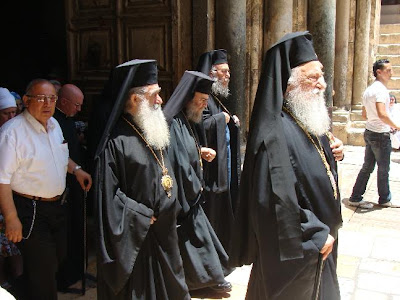This post comes to you live from the
Pontifical Biblical Institute in Jerusalem, where I'll be making my annual eight-day retreat this coming week. I arrived here early Friday morning after a fine four-day stay in the Netherlands. Though this is my second time in Jerusalem, I've already encountered much that is new to me. A short walk from the Jaffa Gate that leads into the Christian Quarter of the Old City, the PBI is located in the "new" part of Jerusalem largely constructed in the last two centuries. Having stayed in the Old City on my previous trip, the "new" Jerusalem is largely unfamiliar to me. This morning, I made a first effort to get to know the newer part of the city by taking a long walk that included visits to the
Israel Museum and the Greek Orthodox
Monastery of the Cross. The Israel Museum's best known exhibit, the portion of the Dead Sea Scrolls displayed within the
Shrine of the Book, was appropriately awe-inspiring. I also enjoyed an exhibit of contemporary Israeli art called "Real Time: Art in Israel, 1998-2008," which received
a very favorable write-up last month in the
New York Times.
Reputedly founded in the 4th century by the Emperor Constantine's mother Helena and rebuilt in the 11th century by Georgian monks, the Monastery of the Cross is so called because it is located in what is traditionally held to be the place where the trees that provided the wood for Christ's cross were grown. Built in what was once an uninhabited valley, the Monastery of the Cross now sits beside a divided highway close to the Israel Museum, the Knesset, and rows of modern apartment buildings. Given that the Monastery of the Cross is still home to a small community of Greek Orthodox monks, I was surprised how much of the building was open to visitors - I was free to explore the monastery church (containing ancient mosaics and some beautiful frescoes), what used to be the kitchen and the refectory, and numerous other parts of the monastic complex. Judging from the signage and some of the items for sale in the gift shop, the Monastery of the Cross seems to attract many visitors from Russia (drawn by the Georgian connection, perhaps, or simply by devotion to the Holy Cross). Speaking of the gift shop, I was pleasantly surprised by the fact that all of the items had price stickers (in contrast with a lot of shops in the Old City, where you have to haggle over the price of anything you might want to buy) and by the fact that the shopkeeper left me alone as I browsed his wares (again, unlike in the Old City, where shopkeepers hover over you and offer constant suggestions about what to buy, even if you tell them you're looking for something totally different).
Not long after I arrived yesterday, I attended the Divine Liturgy at the
Melkite Greek-Catholic Patriarchate near the Jaffa Gate, a short walk from the PBI. Though the liturgy was entirely in Arabic (including some fine singing from the small but clearly very devoted congregation), I still could tell what was going on and had an easy time following along with a French-language missal provided for the use of pilgrims. After the liturgy, I enjoyed a brief chat in French and in English with the priest-celebrant and a couple of Melkite nuns in attendance. This morning I went to Mass at one of my favorite places in Jerusalem, the Benedictine
Dormition Abbey right outside the walls of the Old City. The mostly German monks provided a quietly dignified liturgy with excellent singing (something that Germans as well as Benedictines are often said to do well), and I hope that I have the chance to pray with them again while I'm here.
My retreat begins tomorrow morning, so I won't be posting again for at least a week. I ask for your prayers as I make my retreat here in Jerusalem, and I assure you that I'll be praying for you as well. Until next time,
pax et bonum. AMDG.

























